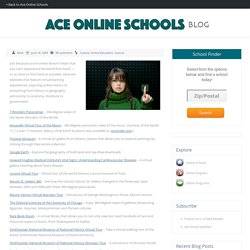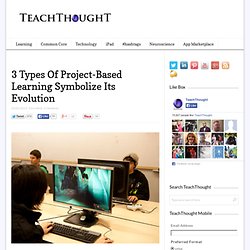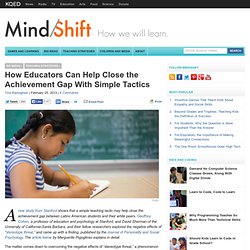

25 Awesome Virtual Learning Experiences Online - Virtual Education Websites. Just because you’re online doesn’t mean that you can’t experience the world first-hand — or as close to first-hand as possible.

Here are websites that feature virtual learning experiences, exposing online visitors to everything from history to geography, astronomy to anatomy, literature to government. 7 Wonders Panoramas – 360-degree views of the Seven Wonders of the World. Arounder Virtual Tour of the Moon – 360-degree panoramic views of the moon, courtesy of the Apollo 11, 12 and 17 missions. (Many other Earth locations also available on arounder.com.)
Frissiras Museum – A virtual art gallery from Athens, Greece that allows you to explore paintings by clicking through their entire collection. Google Earth – Explore the geography of both land and sea (free download). Howard Hughes Medical Institute’s Vital Signs: Understanding Cardiovascular Diseases – A virtual gallery teaching about heart disease. Louvre Virtual Tour – Virtual tour of the world-famous Louvre museum in Paris. Mount St. Creating Classrooms We Need: 8 Ways Into Inquiry Learning. If kids can access information from sources other than school, and if school is no longer the only place where information lives, what, then happens to the role of this institution?

“Our whole reason for showing up for school has changed, but infrastructure has stayed behind,” said Diana Laufenberg, who taught history at the progressive public school Science Leadership Academy for many years. Laufenberg provided some insight into how she guided students to find their own learning paths at school, and enumerated some of these ideas at SXSWEdu last week. 1. BE FLEXIBLE. The less educators try to control what kids learn, the more students’ voices will be heard and, eventually, their ability to drive their own learning. Laufenberg recalled a group of tenacious students who continued to ask permission to focus their video project on the subject of drugs, despite her repeated objections. 2. Laufenberg’s answer: Get them curious enough in the subject to do research on their own. Alistair smith learning.
Jasztalville: Where Inquiry and Creativity Rules: 2012-2013 Jasztalville Classroom Photos (Please give feedback, ask questions, etc.!) Blogs. Inquiry based. PBL. Enquiring Minds. 3 Types Of Project-Based Learning Symbolize Its Evolution. Project-Based Learning is an increasingly popular trend in the 21st century.

The best evidence for this popularity might be the nuance it’s taken on. Project-Based Learning: What is it? Project-based learning (PBL) is a method used to cultivate learning and teach students 21st century skills.

The idea is “built upon authentic learning activities that engage student interest and motivation,” and “generally reflect the types of learning and work people do in everyday world outside the classroom” (pbl-online.org). During project-based learning, students are approached with a complex question, problem, or challenge, which they respond to through a lengthy process of analysis and reflection. These projects are carefully planned, managed, and evaluated—and in the end students have created a high-quality, meaningful product. It wasn’t until I did some research that I realized the concept is much different than the typical classroom project. Some major differences are pointed out in this graph: Source.
Maths. How to teach … superheroes. Lifelong Learning - www.lifelonglearning.co.uk. Technology. Science. Student Launcher - Project "The Quest to Matter" Short Project Description The Quest challenges students to ACCEPT that they matter, to ACCELERATE the message that everyone matters, and to ACT to change our world. What is the outcome of the project? After Angela Maiers challenged listeners in her "You Matter" speech at TedXDes Moines in June 2011, people from around the world - particularly students - reacted powerfully to the call to action.
How Educators Can Help Close the Achievement Gap With Simple Tactics. Big Ideas Teaching Strategies Getty A new study from Stanford shows that a simple teaching tactic may help close the achievement gap between Latino American students and their white peers.

Geoffrey Cohen, a professor of education and psychology at Stanford, and David Sherman of the University of California-Santa Barbara, and their fellow researchers explored the negative effects of “stereotype threat,” and came up with a finding, published by the Journal of Personality and Social Psychology. The article below by Marguerite Rigoglioso explains in detail. The matter comes down to overcoming the negative effects of “stereotype threat,” a phenomenon that researchers have identified and documented over the last two decades.
Rise of violent primary pupils: 40 teachers attacked every day - more than at secondary schools. By Daniel Martin Published: 23:01 GMT, 25 January 2013 | Updated: 23:03 GMT, 25 January 2013 Forty primary school pupils are expelled every day for attacks on staff, shocking figures revealed yesterday.

The violence is so endemic that exclusions for assaulting teachers are now more common in primaries than in secondary schools. Official statistics show that 8,030 pupils aged five to 11 received the sanction in 2010/11 – a 15 per cent rise over four years. For the first time, the number of exclusions at primary schools has overtaken those in secondary schools, which are for those aged 11 to 18 (posed)
Differentiation.